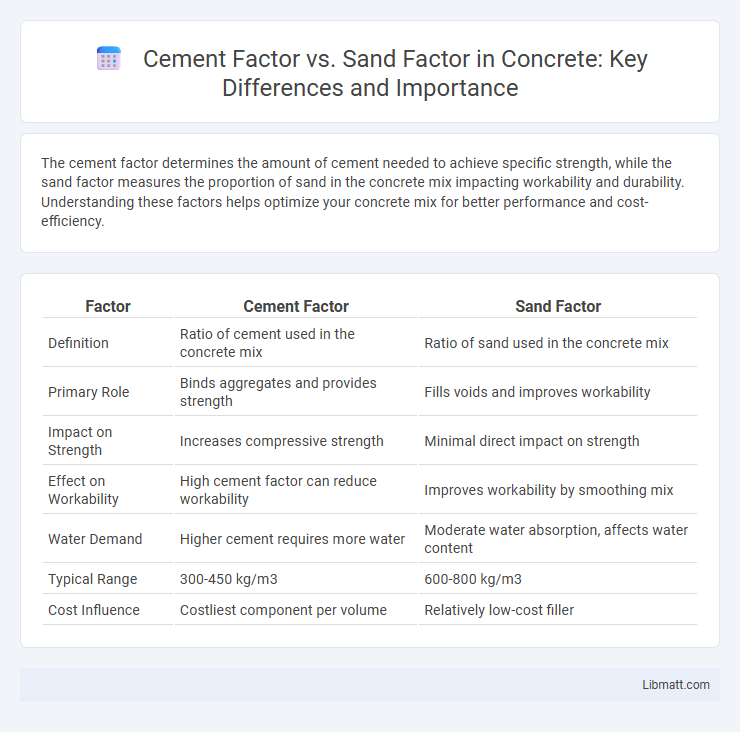The cement factor determines the amount of cement needed to achieve specific strength, while the sand factor measures the proportion of sand in the concrete mix impacting workability and durability. Understanding these factors helps optimize your concrete mix for better performance and cost-efficiency.
Table of Comparison
| Factor | Cement Factor | Sand Factor |
|---|---|---|
| Definition | Ratio of cement used in the concrete mix | Ratio of sand used in the concrete mix |
| Primary Role | Binds aggregates and provides strength | Fills voids and improves workability |
| Impact on Strength | Increases compressive strength | Minimal direct impact on strength |
| Effect on Workability | High cement factor can reduce workability | Improves workability by smoothing mix |
| Water Demand | Higher cement requires more water | Moderate water absorption, affects water content |
| Typical Range | 300-450 kg/m3 | 600-800 kg/m3 |
| Cost Influence | Costliest component per volume | Relatively low-cost filler |
Understanding the Cement Factor
Understanding the cement factor is crucial in concrete mix design, as it directly influences the strength, durability, and workability of the final product. The cement factor refers to the amount of cement in the mix relative to the volume of the concrete, often measured in kilograms per cubic meter, and impacts setting time and hydration processes. Compared to the sand factor, which relates to the fine aggregate content, the cement factor primarily determines the binder quality and overall performance characteristics in structural applications.
Defining the Sand Factor
The sand factor measures the amount of sand in a concrete mix relative to its total volume, typically expressed as a ratio or percentage. It influences workability, strength, and durability by controlling the aggregate-to-cement balance within the mix. Accurate sand factor determination ensures optimal cement paste coverage, reducing voids and enhancing overall concrete performance.
Importance of Balancing Cement and Sand
Balancing cement and sand factors is crucial for achieving optimal concrete strength and durability, as excessive cement can lead to increased costs and shrinkage, while too much sand reduces workability and bonding quality. Proper ratio ensures efficient hydration, maximizing cementitious material performance and maintaining structural integrity. Accurate mix design adjustments tailored to project specifications prevent weaknesses and extend the lifespan of masonry and concrete structures.
Effects of High Cement Factor in Concrete
High cement factor in concrete increases strength and durability by enhancing the binding properties between aggregates and water. Excessive cement content can lead to increased heat of hydration, which may cause thermal cracking and reduce structural integrity over time. Your mix design should balance cement and sand factors to optimize workability and minimize shrinkage.
Consequences of Excess Sand Factor
Excess sand factor in concrete mix leads to reduced strength and durability due to insufficient cement paste to properly bind the aggregates. High sand content increases porosity and permeability, causing accelerated corrosion of reinforcement and decreased resistance to freeze-thaw cycles. This imbalance results in lower compressive strength, compromised structural integrity, and higher maintenance costs over the lifespan of the construction.
Cement vs Sand: Impact on Workability
Higher cement content improves workability by increasing the paste volume, which lubricates the mix, allowing easier placement and consolidation. In contrast, increased sand content can reduce workability due to greater surface area and finer particle size, requiring more water to achieve the same fluidity. Balancing cement and sand proportions is crucial to optimize concrete workability while maintaining strength and durability.
Strength and Durability Considerations
Cement factor directly influences the strength and durability of concrete by increasing the cement content, which enhances the hydration process and results in a denser, more robust matrix. In contrast, sand factor affects the workability and void content within the mix, where an optimal sand proportion ensures proper particle packing and reduces permeability, thereby improving durability. Balancing cement and sand factors is critical to achieving a concrete mix that maximizes compressive strength while minimizing potential deterioration from environmental exposure.
Economic Implications of Cement and Sand Ratios
Balancing cement and sand factors directly impacts the cost efficiency of your construction project, as higher cement content increases material expenses while excess sand can weaken structural integrity, leading to costly repairs. Optimal ratios ensure durable concrete with minimized wastage and reduced need for costly maintenance or reconstruction. Understanding these economic implications helps you achieve cost-effective mixing that supports long-term savings without compromising quality.
Environmental Impact of Cement and Sand Usage
Cement production is a major source of CO2 emissions, contributing approximately 8% of global carbon emissions, whereas sand extraction primarily disrupts aquatic ecosystems and causes habitat loss. The high energy consumption in cement manufacturing contrasts with the localized environmental degradation from sand mining, such as riverbank erosion and groundwater depletion. Sustainable alternatives and efficient usage strategies in both cement and sand can significantly reduce their ecological footprints in construction projects.
Best Practices for Optimizing Cement and Sand Proportions
Optimizing cement and sand proportions requires balancing the cement factor to ensure sufficient strength and durability while adjusting the sand factor to enhance workability and reduce voids in the mortar mix. Accurate measurement and consistent batching of both components are crucial for achieving optimal bonding and minimizing shrinkage or cracking in concrete structures. You should conduct trial mixes and adjust ratios based on the specific application and environmental conditions to maintain structural integrity and cost-effectiveness.
Cement factor vs Sand factor Infographic

 libmatt.com
libmatt.com